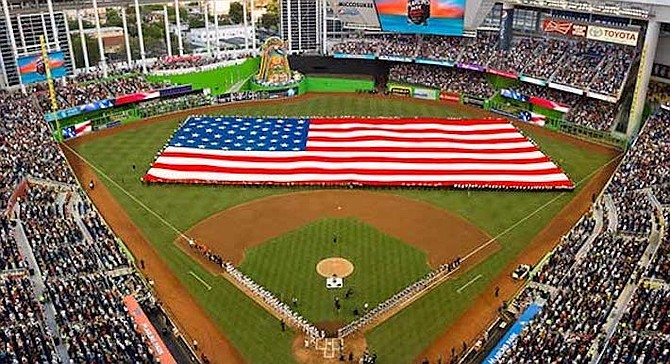 Facebook
Facebook
 X
X
 Instagram
Instagram
 TikTok
TikTok
 Youtube
Youtube

Increasingly, the media, politicians, and city leaders around the U.S. are understanding that taxpayer subsidies of pro stadiums are complete scams.

Yesterday, the New York Times panned Marlins Park, the Miami stadium that will host the All-Star Game July 11. A decade ago, taxpayers paid three-fourths of the $650 million retractable-roof stadium. The Marlins argued that fans weren't turning out because of the rain and humidity. Even now with a roof, they are still not turning out; the team continues to stink. The total cost to taxpayers will be $2 billion over the life of the bonds.
The mayor of Miami-Dade County, Carlos Gimenez, was one of the few to oppose the subsidy when he was a county commissioner. Now, he notes that the team owner, Jeffrey Loria, wants to sell the team for $1.2 billion, eight times what he paid for the Marlins. Loria, if he can unload the team, will stick hundreds of millions of dollars in his pocket, thanks to Miami area taxpayers, says Gimenez.
Neil deMause of the online newsletter fieldofschemes.com is an ardent opponent of subsidies for billionaire team owners, but he doesn't think Loria will rake in his bundle because of the subsidy. The team apparently has $400 million in debt. So if you figure that Loria nets $800 million, he will make a profit of 11.41 percent per year. That's about what baseball owners make, according to Forbes numbers, and the former owner of the Los Angeles Dodgers got a 21 percent windfall without getting a stadium.
Neil de Mause says Loria may have remained "obscenely wealthy" even without the subsidy. I question that, because new subsidized stadiums generally boost the value of a team. Hopefully, subsidy discussions will escalate around the time of the big game July 11.


Increasingly, the media, politicians, and city leaders around the U.S. are understanding that taxpayer subsidies of pro stadiums are complete scams.

Yesterday, the New York Times panned Marlins Park, the Miami stadium that will host the All-Star Game July 11. A decade ago, taxpayers paid three-fourths of the $650 million retractable-roof stadium. The Marlins argued that fans weren't turning out because of the rain and humidity. Even now with a roof, they are still not turning out; the team continues to stink. The total cost to taxpayers will be $2 billion over the life of the bonds.
The mayor of Miami-Dade County, Carlos Gimenez, was one of the few to oppose the subsidy when he was a county commissioner. Now, he notes that the team owner, Jeffrey Loria, wants to sell the team for $1.2 billion, eight times what he paid for the Marlins. Loria, if he can unload the team, will stick hundreds of millions of dollars in his pocket, thanks to Miami area taxpayers, says Gimenez.
Neil deMause of the online newsletter fieldofschemes.com is an ardent opponent of subsidies for billionaire team owners, but he doesn't think Loria will rake in his bundle because of the subsidy. The team apparently has $400 million in debt. So if you figure that Loria nets $800 million, he will make a profit of 11.41 percent per year. That's about what baseball owners make, according to Forbes numbers, and the former owner of the Los Angeles Dodgers got a 21 percent windfall without getting a stadium.
Neil de Mause says Loria may have remained "obscenely wealthy" even without the subsidy. I question that, because new subsidized stadiums generally boost the value of a team. Hopefully, subsidy discussions will escalate around the time of the big game July 11.
Comments